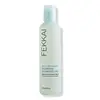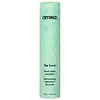What's inside
What's inside
 Key Ingredients
Key Ingredients

No key ingredients
 Benefits
Benefits

 Concerns
Concerns

 Ingredients Side-by-side
Ingredients Side-by-side

Water
Skin ConditioningSodium Cocoyl Isethionate
CleansingSodium Lauroyl Methyl Isethionate
CleansingCocamidopropyl Betaine
CleansingCocamide Mipa
EmulsifyingSodium Methyl Oleoyl Taurate
CleansingCoconut Acid
CleansingBrassica Campestris Seed Oil
Skin ConditioningAdansonia Digitata Seed Oil
EmollientPanthenol
Skin ConditioningTocopherol
AntioxidantParfum
MaskingDisodium PEG-12 Dimethicone Sulfosuccinate
CleansingPCA Dimethicone
Skin ConditioningAminomethyl Propanol
BufferingButylene Glycol
HumectantSesamum Indicum Seed Oil
EmollientEmblica Officinalis Fruit Extract
Skin ConditioningPropanediol
SolventSodium PCA
HumectantPolyquaternium-73
Coco-Glucoside
CleansingLauryl Glucoside
CleansingSodium Isethionate
CleansingCaprylyl Glycol
EmollientEthylhexylglycerin
Skin ConditioningSodium Hydroxide
BufferingGuar Hydroxypropyltrimonium Chloride
Skin ConditioningTetrasodium Glutamate Diacetate
Citric Acid
BufferingSodium Benzoate
MaskingPhenoxyethanol
PreservativeCoumarin
PerfumingWater, Sodium Cocoyl Isethionate, Sodium Lauroyl Methyl Isethionate, Cocamidopropyl Betaine, Cocamide Mipa, Sodium Methyl Oleoyl Taurate, Coconut Acid, Brassica Campestris Seed Oil, Adansonia Digitata Seed Oil, Panthenol, Tocopherol, Parfum, Disodium PEG-12 Dimethicone Sulfosuccinate, PCA Dimethicone, Aminomethyl Propanol, Butylene Glycol, Sesamum Indicum Seed Oil, Emblica Officinalis Fruit Extract, Propanediol, Sodium PCA, Polyquaternium-73, Coco-Glucoside, Lauryl Glucoside, Sodium Isethionate, Caprylyl Glycol, Ethylhexylglycerin, Sodium Hydroxide, Guar Hydroxypropyltrimonium Chloride, Tetrasodium Glutamate Diacetate, Citric Acid, Sodium Benzoate, Phenoxyethanol, Coumarin
Water
Skin ConditioningSodium C14-16 Olefin Sulfonate
CleansingCocamidopropyl Betaine
CleansingGlycerin
HumectantDisodium Cocoamphodiacetate
CleansingPEG-7 Glyceryl Cocoate
EmulsifyingHippophae Rhamnoides Fruit/Seed Oil
AntimicrobialBorago Officinalis Seed Oil
EmollientPersea Gratissima Oil
Skin ConditioningMangifera Indica Seed Butter
Skin ConditioningButyrospermum Parkii Butter
Skin ConditioningHydroxypropyl Guar Hydroxypropyltrimonium Chloride
Lavandula Angustifolia Flower Extract
CleansingChamomilla Recutita Flower Extract
MaskingRosmarinus Officinalis Leaf Extract
AntimicrobialHydrolyzed Quinoa
Skin ConditioningAminomethyl Propanol
BufferingBis-PCA Dimethicone
Butylene Glycol
HumectantSodium Gluconate
Skin ConditioningDisodium PEG-12 Dimethicone Sulfosuccinate
CleansingPEG-12 Dimethicone
Skin ConditioningPEG-150 Distearate
EmulsifyingPolyquaternium-10
Polyquaternium-7
Polysorbate 20
EmulsifyingPropylene Glycol
HumectantGlycol
HumectantGlycol Stearate
EmollientGlycol Distearate
EmollientSodium Methyl Cocoyl Taurate
CleansingCitric Acid
BufferingDehydroacetic Acid
PreservativeBenzyl Alcohol
PerfumingPhenoxyethanol
PreservativePotassium Sorbate
PreservativeSodium Benzoate
MaskingBenzoic Acid
MaskingParfum
MaskingWater, Sodium C14-16 Olefin Sulfonate, Cocamidopropyl Betaine, Glycerin, Disodium Cocoamphodiacetate, PEG-7 Glyceryl Cocoate, Hippophae Rhamnoides Fruit/Seed Oil, Borago Officinalis Seed Oil, Persea Gratissima Oil, Mangifera Indica Seed Butter, Butyrospermum Parkii Butter, Hydroxypropyl Guar Hydroxypropyltrimonium Chloride, Lavandula Angustifolia Flower Extract, Chamomilla Recutita Flower Extract, Rosmarinus Officinalis Leaf Extract, Hydrolyzed Quinoa, Aminomethyl Propanol, Bis-PCA Dimethicone, Butylene Glycol, Sodium Gluconate, Disodium PEG-12 Dimethicone Sulfosuccinate, PEG-12 Dimethicone, PEG-150 Distearate, Polyquaternium-10, Polyquaternium-7, Polysorbate 20, Propylene Glycol, Glycol, Glycol Stearate, Glycol Distearate, Sodium Methyl Cocoyl Taurate, Citric Acid, Dehydroacetic Acid, Benzyl Alcohol, Phenoxyethanol, Potassium Sorbate, Sodium Benzoate, Benzoic Acid, Parfum
 Reviews
Reviews

Ingredients Explained
These ingredients are found in both products.
Ingredients higher up in an ingredient list are typically present in a larger amount.
Aminomethyl Propanol is used to adjust the pH of products. It is also used as a base to create other organic compounds. Having a balanced pH is important for protecting your skin.
Aminomethyl propanol is safe to use in cosmetics up to 1%. It is soluble in water.
Butylene Glycol (or BG) is used within cosmetic products for a few different reasons:
Overall, Butylene Glycol is a safe and well-rounded ingredient that works well with other ingredients.
Though this ingredient works well with most skin types, some people with sensitive skin may experience a reaction such as allergic rashes, closed comedones, or itchiness.
Learn more about Butylene GlycolCitric Acid is an alpha hydroxy acid (AHA) naturally found in citrus fruits like oranges, lemons, and limes.
Like other AHAs, citric acid can exfoliate skin by breaking down the bonds that hold dead skin cells together. This helps reveal smoother and brighter skin underneath.
However, this exfoliating effect only happens at high concentrations (20%) which can be hard to find in cosmetic products.
Due to this, citric acid is usually included in small amounts as a pH adjuster. This helps keep products slightly more acidic and compatible with skin's natural pH.
In skincare formulas, citric acid can:
While it can provide some skin benefits, research shows lactic acid and glycolic acid are generally more effective and less irritating exfoliants.
Most citric acid used in skincare today is made by fermenting sugars (usually from molasses). This synthetic version is identical to the natural citrus form but easier to stabilize and use in formulations.
Read more about some other popular AHA's here:
Learn more about Citric AcidCocamidopropyl Betaine is a fatty acid created by mixing similar compounds in coconut oil and dimethylaminopropylamine, a compound with two amino groups.
This ingredient is a surfactant and cleanser. It helps gather the dirt, pollutants, and other impurities in your skin to be washed away. It also helps thicken a product and make the texture more creamy.
Being created from coconut oil means Cocamidopropyl Betaine is hydrating for the skin.
While Cocamidopropyl Betaine was believed to be an allergen, a study from 2012 disproved this. It found two compounds in unpure Cocamidopropyl Betaine to be the irritants: aminoamide and 3-dimethylaminopropylamine. High-grade and pure Cocamidopropyl Betaine did not induce allergic reactions during this study.
Learn more about Cocamidopropyl BetaineDisodium PEG-12 Dimethicone Sulfosuccinate is a type of silicone.
Parfum is a catch-all term for an ingredient or more that is used to give a scent to products.
Also called "fragrance", this ingredient can be a blend of hundreds of chemicals or plant oils. This means every product with "fragrance" or "parfum" in the ingredients list is a different mixture.
For instance, Habanolide is a proprietary trade name for a specific aroma chemical. When used as a fragrance ingredient in cosmetics, most aroma chemicals fall under the broad labeling category of “FRAGRANCE” or “PARFUM” according to EU and US regulations.
The term 'parfum' or 'fragrance' is not regulated in many countries. In many cases, it is up to the brand to define this term.
For instance, many brands choose to label themselves as "fragrance-free" because they are not using synthetic fragrances. However, their products may still contain ingredients such as essential oils that are considered a fragrance by INCI standards.
One example is Calendula flower extract. Calendula is an essential oil that still imparts a scent or 'fragrance'.
Depending on the blend, the ingredients in the mixture can cause allergies and sensitivities on the skin. Some ingredients that are known EU allergens include linalool and citronellol.
Parfum can also be used to mask or cover an unpleasant scent.
The bottom line is: not all fragrances/parfum/ingredients are created equally. If you are worried about fragrances, we recommend taking a closer look at an ingredient. And of course, we always recommend speaking with a professional.
Learn more about ParfumPhenoxyethanol is a preservative that has germicide, antimicrobial, and aromatic properties. Studies show that phenoxyethanol can prevent microbial growth. By itself, it has a scent that is similar to that of a rose.
It's often used in formulations along with Caprylyl Glycol to preserve the shelf life of products.
Sodium Benzoate is a preservative. It's used in both cosmetic and food products to inhibit the growth of mold and bacteria. It is typically produced synthetically.
Both the US FDA and EU Health Committee have approved the use of sodium benzoate. In the US, levels of 0.1% (of the total product) are allowed.
Sodium benzoate works as a preservative by inhibiting the growth of bacteria inside of cells. It prevents the cell from fermenting a type of sugar using an enzyme called phosphofructokinase.
It is the salt of benzoic acid. Foods containing sodium benzoate include soda, salad dressings, condiments, fruit juices, wines, and snack foods.
Studies for using ascorbic acid and sodium benzoate in cosmetics are lacking, especially in skincare routines with multiple steps.
We always recommend speaking with a professional, such as a dermatologist, if you have any concerns.
Learn more about Sodium BenzoateWater. It's the most common cosmetic ingredient of all. You'll usually see it at the top of ingredient lists, meaning that it makes up the largest part of the product.
So why is it so popular? Water most often acts as a solvent - this means that it helps dissolve other ingredients into the formulation.
You'll also recognize water as that liquid we all need to stay alive. If you see this, drink a glass of water. Stay hydrated!
Learn more about Water